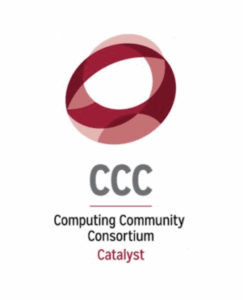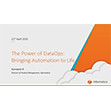
Computing Community Consortium Outlines Roadmap for Long-Term AI Research
Aug. 8, 2025 — The world is buzzing about artificial intelligence (AI), driven by the remarkable advancements in deep neural networks, large language models, and other types of foundation models. But what’s next? A new whitepaper, “Envisioning Possible Futures for AI Research,” from the Computing Community Consortium (CCC) dives into this crucial question, suggesting that the current wave of AI innovation, while powerful, is built on a paradigm that’s already 15 years old.
 “The current paradigm, while incredibly successful, is not the endpoint,” says David Jensen, one of the paper’s authors from the University of Massachusetts Amherst. “For AI to continue to progress over the long term, we need researchers to be actively exploring along a broad front so that we can enable the next major revolution in AI.”
“The current paradigm, while incredibly successful, is not the endpoint,” says David Jensen, one of the paper’s authors from the University of Massachusetts Amherst. “For AI to continue to progress over the long term, we need researchers to be actively exploring along a broad front so that we can enable the next major revolution in AI.”
Why Look to the Future Now?
AI has a rich history of paradigm shifts, from symbolic processing to knowledge-based systems and statistical machine learning. Each brought transformative applications, and each was eventually superseded. The current dominance of deep neural networks, while impressive, is starting to reveal its limitations in areas like reasoning and causal understanding.
To further explore this area, the authors convened a series of roundtable discussions with fellows from the Association for the Advancement of Artificial Intelligence (AAAI). Drawing from these conversations, the authors penned this new whitepaper to emphasize the importance of exploring alternative paradigms. Such research would balance current exploitation with new exploration, promote revolutionary AI advances over incremental ones, and correct the public misconception that “AI is done, except for the scaling.”
“It’s easy to get caught up in the excitement of what’s working now,” notes Matthew Turk, President of the Toyota Technological Institute at Chicago and co-author. “But history shows us that true breakthroughs come from exploring what’s next, often before its full potential is clear.”
Six Potential AI Research Futures
The CCC Task Force on AI Research Futures, composed of the paper’s authors, convened AI experts to identify and refine potential future paradigms. The authors chose to focus on research futures that:
- Possess a central theme or set of core principles and have clear boundaries as to what a given research future encompasses,
- Are possible, though not necessarily likely,
- Describe both the end goals and means of achieving these goals, and
- Are motivated by specific technical issues.
They identified six compelling possibilities:
- Neuro-Symbolic AI: This paradigm aims to merge the pattern-learning prowess of deep neural networks with the logical reasoning capabilities of symbolic AI. Imagine AI systems that not only recognize a cat but also understand the abstract concept of “cat” and can reason about it.
- Neuromorphic AI: Instead of just being “brain-inspired,” neuromorphic computing directly mimics the structure and behavior of neurons in hardware. This approach promises significant advantages in power efficiency and latency, particularly for mobile and embedded devices.
- Embodied AI: Moving beyond purely computational intelligence, embodied AI systems have a physical presence, perceiving, acting, and learning within physical environments. This direct interaction allows for a deeper understanding of causality and spatial relationships, mirroring how biological intelligence develops.
- Multi-Agent AI: This paradigm envisions an ecosystem of specialized AI agents collaborating and coordinating to achieve complex goals. Rather than one monolithic AI, a “team” of AIs can tackle complex problems, with each individual model expertly handling a specific part of that problem.
- Human-Centered AI: This approach prioritizes the integration of human and machine cognition, aiming to augment human capabilities rather than replace them. It focuses on AI systems with social intelligence that can detect and respond to complex social cues and interact in nuanced ways.
- Quantum AI: Still speculative, Quantum AI exploits emerging principles of quantum computing to enhance AI. This could advance optimization and search problems, or enable physical simulations with unprecedented accuracy.
The Road Ahead
While continued advancements in deep neural networks are expected, the paper underscores that sustained investment in high-risk, long-term research—typically supported by government funding—is crucial for seeding the next AI revolution. This intentional investment strategy, supporting a diversified portfolio of alternative paradigms, is precisely what led to the current era of AI innovation. As Holly Yanco, co-author and professor at the University of Massachusetts Lowell, puts it, “The future of AI is not about a single path, but about exploring a multitude of promising avenues simultaneously.”
Check out the full whitepaper here.
About Computing Community Consortium (CCC)
The goal of the Computing Community Consortium (CCC) is to catalyze the computing research community to debate longer range, more audacious research challenges; to build consensus around research visions; to evolve the most promising visions toward clearly defined initiatives; and to work with the funding organizations to move challenges and visions toward funding initiatives. The purpose of this blog is to provide a more immediate, online mechanism for dissemination of visioning concepts and community discussion/debate about them.
Source: Catherine Gill, Computing Community Consortium (CCC)



























